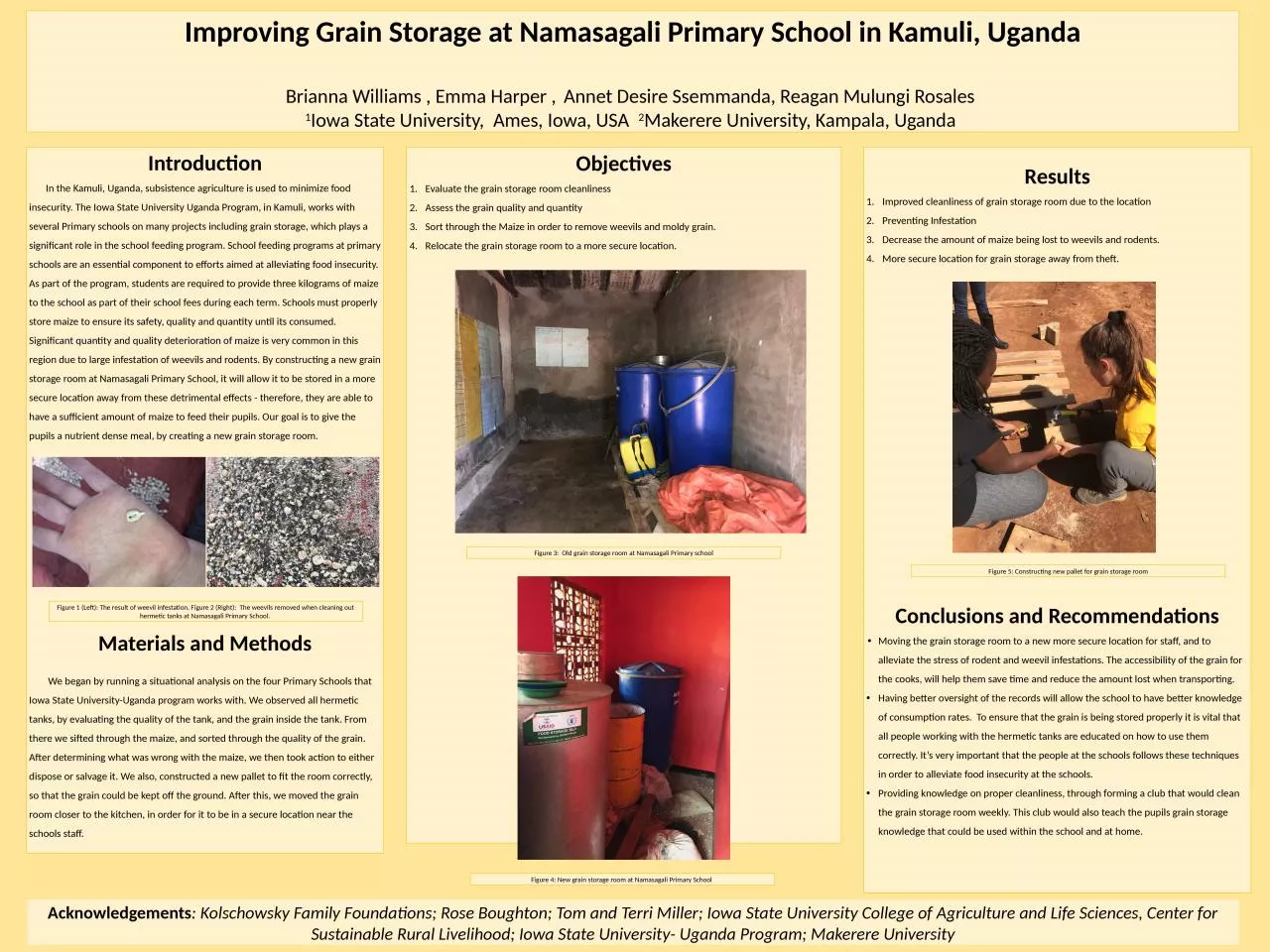

Brianna Williams Emma Harper Annet Desire Ssemmanda Reagan Mulungi Rosales 1 Iowa State University Ames Iowa USA 2 Makerere University Kampala Uganda Introduction ID: 926963
Download Presentation The PPT/PDF document "Improving Grain Storage at Namasagali Pr..." is the property of its rightful owner. Permission is granted to download and print the materials on this web site for personal, non-commercial use only, and to display it on your personal computer provided you do not modify the materials and that you retain all copyright notices contained in the materials. By downloading content from our website, you accept the terms of this agreement.
Slide1
Improving Grain Storage at Namasagali Primary School in Kamuli, Uganda Brianna Williams , Emma Harper , Annet Desire Ssemmanda, Reagan Mulungi Rosales 1Iowa State University, Ames, Iowa, USA 2Makerere University, Kampala, Uganda
Introduction In the Kamuli, Uganda, subsistence agriculture is used to minimize food insecurity. The Iowa State University Uganda Program, in Kamuli, works with several Primary schools on many projects including grain storage, which plays a significant role in the school feeding program. School feeding programs at primary schools are an essential component to efforts aimed at alleviating food insecurity. As part of the program, students are required to provide three kilograms of maize to the school as part of their school fees during each term. Schools must properly store maize to ensure its safety, quality and quantity until its consumed. Significant quantity and quality deterioration of maize is very common in this region due to large infestation of weevils and rodents. By constructing a new grain storage room at Namasagali Primary School, it will allow it to be stored in a more secure location away from these detrimental effects - therefore, they are able to have a sufficient amount of maize to feed their pupils. Our goal is to give the pupils a nutrient dense meal, by creating a new grain storage room.Materials and Methods We began by running a situational analysis on the four Primary Schools that Iowa State University-Uganda program works with. We observed all hermetic tanks, by evaluating the quality of the tank, and the grain inside the tank. From there we sifted through the maize, and sorted through the quality of the grain. After determining what was wrong with the maize, we then took action to either dispose or salvage it. We also, constructed a new pallet to fit the room correctly, so that the grain could be kept off the ground. After this, we moved the grain room closer to the kitchen, in order for it to be in a secure location near the schools staff.
ResultsImproved cleanliness of grain storage room due to the locationPreventing Infestation Decrease the amount of maize being lost to weevils and rodents.More secure location for grain storage away from theft.Conclusions and RecommendationsMoving the grain storage room to a new more secure location for staff, and to alleviate the stress of rodent and weevil infestations. The accessibility of the grain for the cooks, will help them save time and reduce the amount lost when transporting.Having better oversight of the records will allow the school to have better knowledge of consumption rates. To ensure that the grain is being stored properly it is vital that all people working with the hermetic tanks are educated on how to use them correctly. It’s very important that the people at the schools follows these techniques in order to alleviate food insecurity at the schools. Providing knowledge on proper cleanliness, through forming a club that would clean the grain storage room weekly. This club would also teach the pupils grain storage knowledge that could be used within the school and at home.
Acknowledgements: Kolschowsky Family Foundations; Rose Boughton; Tom and Terri Miller; Iowa State University College of Agriculture and Life Sciences, Center for Sustainable Rural Livelihood; Iowa State University- Uganda Program; Makerere University
ObjectivesEvaluate the grain storage room cleanliness Assess the grain quality and quantity Sort through the Maize in order to remove weevils and moldy grain.Relocate the grain storage room to a more secure location.
Figure 3: Old grain storage room at Namasagali Primary school
Figure 4: New grain storage room at Namasagali Primary School
Figure 1 (Left): The result of weevil infestation. Figure 2 (Right): The weevils removed when cleaning out hermetic tanks at Namasagali Primary School.
Figure 5: Constructing new pallet for
grain storage room